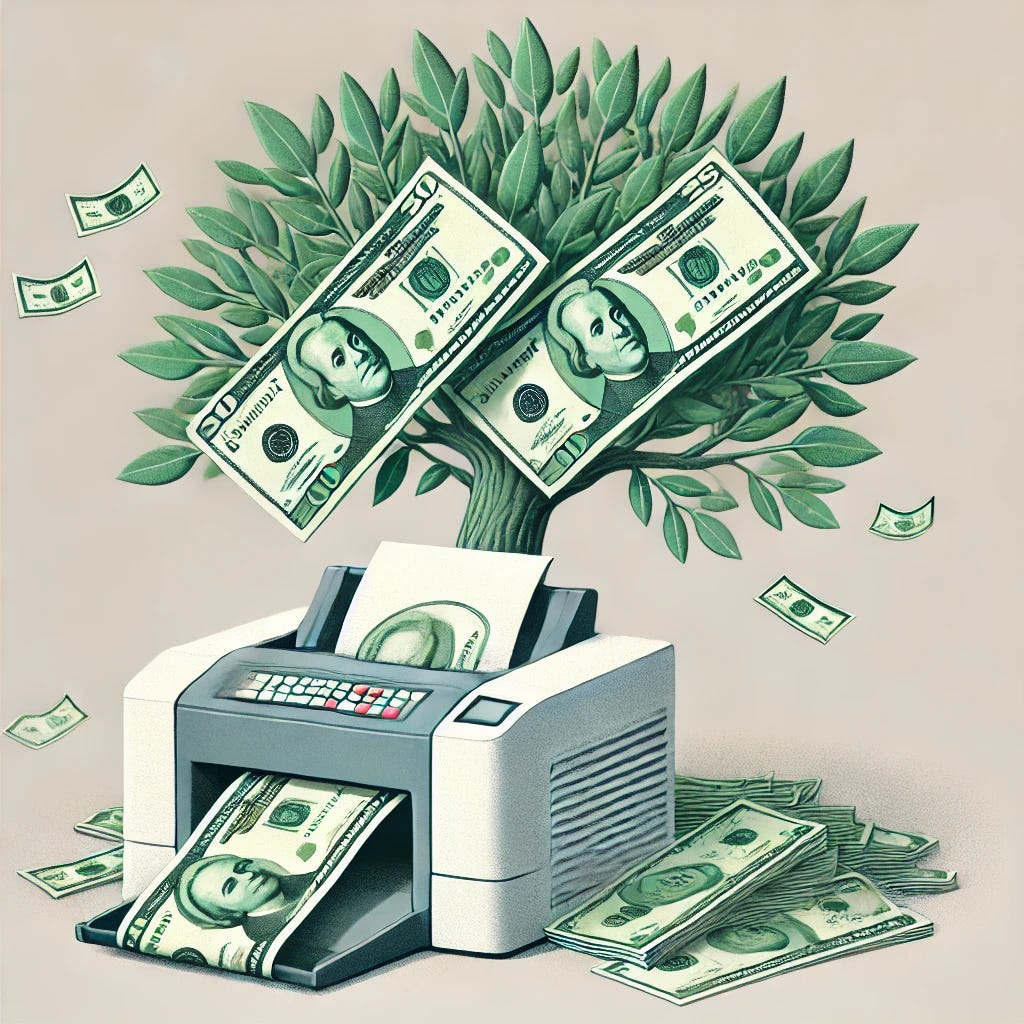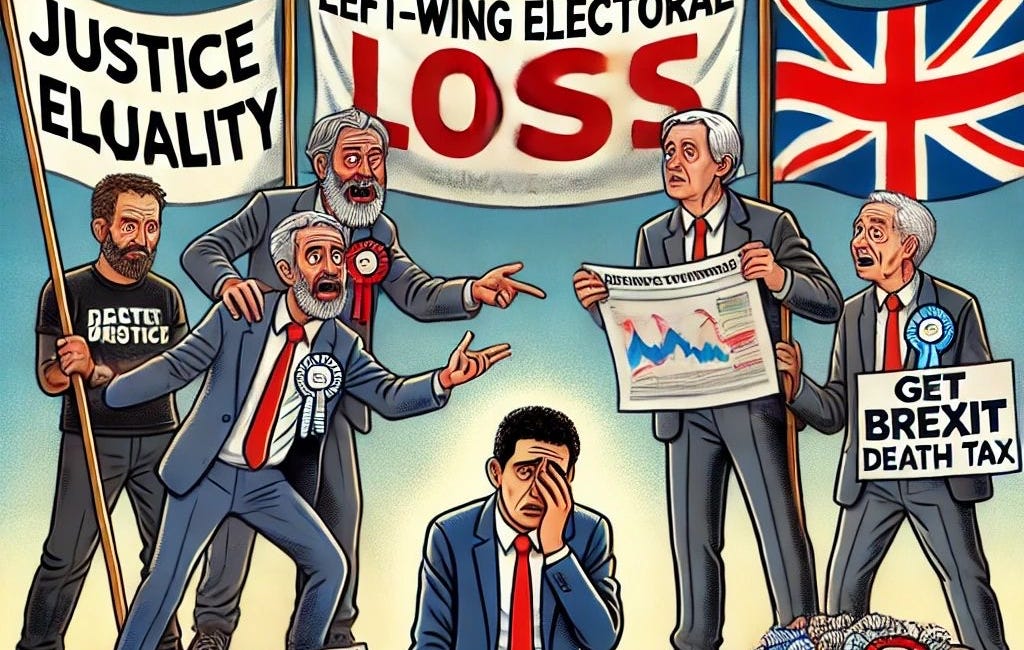Money Grows on Trees: A Layman's Guide to Modern Monetary Theory (MMT)
How Printing Money Can Save Us from Ourselves (And the Planet)
So, what if I told you the government doesn’t need to “find” money to pay for healthcare, education, or even to combat climate change? Nope, no pirate treasure, no mysterious vault of gold bars. Sounds ridiculous, right? Enter Modern Monetary Theory (MMT), the economics framework that claims we’ve been running the economy like we’re still hunting for gold nuggets in a riverbed. Spoiler alert: We're not.
MMT is a pretty revolutionary way to look at modern economies. It argues that as long as a country controls its own currency (like the US with the dollar or the UK with the pound), it can create as much money as it needs. The real worry, it says, shouldn’t be about running out of money, because, technically, governments can always print more, but about inflation, resource constraints and what we’re choosing to spend the money on.
What Exactly Is MMT?
At its core, MMT is like a breath of fresh air for any economy that’s currently being choked by fear of deficits and national debt. The old-school view has been that governments, like households, need to balance their budgets, spend only what they earn and borrow if necessary. This household-budget mentality has led many countries to slash spending on vital services like healthcare, education, and green infrastructure. According to MMT, this mindset is outdated and problematic because governments are not households.
A country that controls its own currency can theoretically spend money freely to solve its problems without worrying about running out. That means governments could pay for anything—schools, hospitals, green energy solutions, a holiday to Fiji for every citizen if they wanted to. The catch? They need to watch inflation and the rise in prices, like a hawk. Too much spending can cause inflation, and too little can lead to unemployment and stagnation. It’s a balancing act.
Inflation: The Real Issue (But Manageable)
Here’s the thing: Governments can’t actually “run out” of money. But they *can* run out of things to buy. If the government pumps too much money into the economy without enough goods and services to absorb it, inflation kicks in. It’s like handing everyone VIP passes to a concert that has limited seats, you’ll end up with a whole lot of angry people who still can’t see Taylor Swift.
That’s where taxation and careful planning come in. MMT sees taxes not as a way to fund government spending (since the government can technically print what it needs), but as a tool to control inflation. Taxes take money out of circulation, reducing the risk of inflation when too much cash is floating around.
Why MMT Matters Right Now
Given the state of the world—rising unemployment, underfunded social services, and a planet that’s literally burning, MMT offers a way out of the economic doom loop. Traditional economics often ties us down, suggesting that governments can’t afford to make massive investments in green energy, healthcare, or education without first “finding the money.” MMT flips this on its head: the money is already there. The challenge is making sure it's spent in the right places and in a way that avoids inflation.
Countries can use MMT principles to pump money into crucial areas like:
1. Climate Change: Green infrastructure projects, clean energy investments, and environmental protection.
2. Healthcare & Education: Expanding access, improving quality, and ensuring that these essential services are fully funded.
3. Social Care: Tackling poverty, homelessness, and supporting the vulnerable—MMT says, “Why not?”
A great example is the US’s Inflation Reduction Act, which was essentially a green investment bill. Through MMT thinking, the government allocated hundreds of billions of dollars to help tackle climate change without getting caught up in the "where will the money come from" debate.
Deficits: The Good, the Bad, and the Misunderstood
People freak out when they hear the word “deficit.” It's been branded as inherently bad. But guess what? With MMT, every deficit the government runs is a surplus for someone else—usually the people. When the government spends more than it taxes, it’s putting money into the economy. That means more cash for the public to spend, save, or invest. The real question is: Who’s benefiting from these deficits? Are they serving the ultra-wealthy or the wider population?
Of course, it's crucial to be mindful of *what* the deficit is funding. Tax cuts for the rich? Probably not the best use of public money. Investments in infrastructure, healthcare, or renewable energy? Now we’re talking.
MMT and Climate Change: A Perfect Match?
Climate change is one of the most significant threats we face, and it requires a massive financial response—much more than most governments are currently willing to commit. MMT shows that money isn’t the obstacle. Instead, governments need to focus on making the necessary investments in green technology, infrastructure, and renewable energy to ensure a sustainable future. The government could essentially “fund” the transition to a green economy without worrying about "finding the money," as long as it manages inflation, ideally supports job creation and keeps a close eye on resource constraints.
But What About Debt?
MMT also challenges the obsession with national debt. In a nutshell, it argues that debt is not inherently bad. Government debt isn’t like your credit card debt—it’s not something that has to be paid off, nor is it an indicator of economic doom. Countries like Japan have been running large deficits for years without falling apart. As long as a country is borrowing in its own currency, it can always repay its debt.
What’s the damn problem then?
So, why isn’t everyone on board with MMT? One of the major reasons for the resistance comes from the banking industry, which sees government spending under MMT as a competitor to their lending operations. Banks make money by lending with interest, and when the government steps in to directly inject funds into the economy—no loans, no strings attached, it reduces the need for people to borrow. We saw this through Covid, when for some people it was the first time in their entire lives, they actually had extra money to spare. In essence, MMT threatens to disrupt the status quo where banks play a central role in the financial system. And it’s not just the banks; many governments are reluctant to embrace MMT because it challenges long-held beliefs about fiscal discipline. Traditional economic thinking still clings to the idea that deficits are inherently bad, and changing that mindset can feel like asking people to unlearn everything they thought they knew about managing money.
The Case for MMT in a Time of Crisis
We’re facing a critical moment in history. Traditional economics would have us believe that we can’t afford to tackle the enormous problems of climate change, inequality, and crumbling infrastructure. MMT says we can, and it shows how. The biggest limitation isn’t money—it’s our imagination and political will. And as long as we stay mindful of inflation, MMT offers a promising way forward.
Economist, Stephanie Kelton, one of the leading voices in Modern Monetary Theory, and one of my main sources of information in writing this article and has brought her expertise to the forefront of economic debate. A professor of economics and public policy at Stony Brook University, Kelton has served as chief economist on the U.S. Senate Budget Committee and advised Senator Bernie Sanders during his presidential campaigns. Her 2020 book The Deficit Myth became a bestseller, challenging conventional economic wisdom and advocating for a new approach to public finance.
I have seen Kelton speak several times over the past 12 months and her latest endeavor, the feature-length documentary Finding the Money, which takes viewers on a compelling journey through MMT. The film explores how societies can shift their understanding of national debt, making the case that governments like the U.S. can afford to address urgent issues such as climate change and inequality, simply by rethinking how we approach public spending. The documentary unpacks the common misconceptions about deficits and debt, showcasing how MMT offers a more flexible framework for addressing 21st-century challenges. Through a series of interviews and thought-provoking examples, Finding the Money highlights the transformative power of embracing a new economic narrative, one that is essential for tackling global crises like climate change.
If you want to challenge your ideas about how money works and how we can afford to build a better future, Finding the Money is a must-watch, you can find out how and where to watch it here.
I know my readers: Smart, attractive and very easily flattered… Would you like to buy me a coffee? 😉 👇
Full URLs for References:
Stephanie Kelton's explanation of MMT:
https://stephaniekelton.com
United States Inflation Reduction Act (2022): https://www.congress.gov/bill/117th-congress/house-bill/5376
Basic principles of MMT from academic sources:
https://neweconomicthinking.org/what-is-mmt/
https://www.ineteconomics.org/research/experts/stephaniekelton








Hooray! Someone with a platform is talking about Modern Monetary Theory (MMT)!
I learned MMT in 2015 and I have joined the ranks of its supporters who believe in Each One Teach One, but it has been a thankless struggle for the most part.
Thank YOU!
Thanks for taking the time to write this, James. Once again your pattern recognition and ability to lay things out in digestible pieces serves you and your readers well. This particular article reminds of Dougald Lamont, except you write primers that people can actually deploy as part of the resistance.